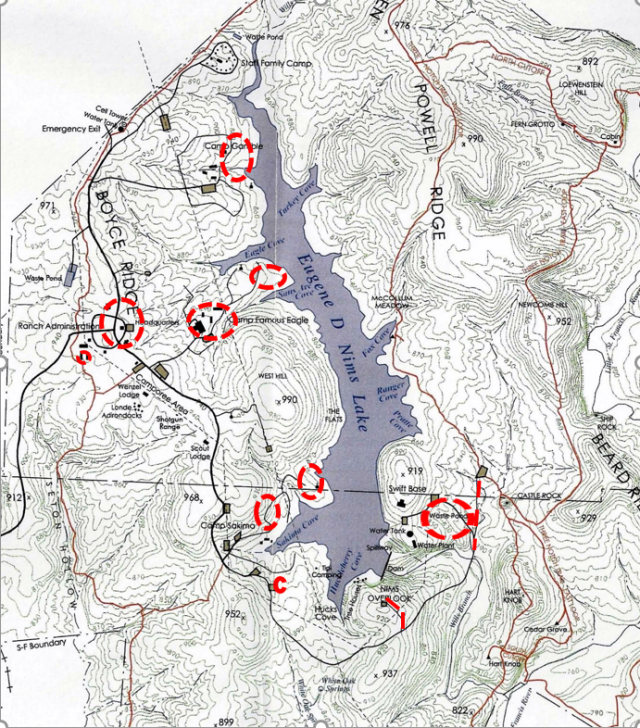S-F Boy Scout Camp, Madison County Mines National Priorities List (NPL) Superfund Site, Madison County, Missouri - Fact Sheet, July 2021
Lead Cleanup

Introduction
The U.S. Environmental Protection Agency (EPA) Region 7 has been remediating (cleaning up) lead-contaminated soil in residential properties within the Madison County Mines National Priorities List (NPL) Superfund Site (site) for over 20 years. The site covers Madison County in its entirety and the Mine La Motte tract in southern St. Francois County. EPA recently completed a lead cleanup at the S-F Boy Scout Camp in northern Madison County.
What Is Lead?
Lead is a naturally occurring element. However, most lead found in the environment is due to human activity. Lead is a toxic metal that can be harmful to humans, especially children, if they come in contact with it. A person can encounter lead through ingesting (eating or drinking) something with lead in it or through inhaling (breathing) lead dust. Lead was commonly used in household paint (banned in 1978), gasoline (banned in 1995), and older plumbing pipes and fixtures. Its deposition also results from lead mining, milling and smelting activities. Lead exposure can affect brain development and cause learning disorders, especially in children; it can also damage vital organs.
More information on the health impacts of lead and the remediation efforts in Madison County can be found online.

History of Lead Issues in Madison County
- From the 1700s to the 1900s, lead mining occurred in southeastern Missouri. This area was one of the largest lead-producing regions in the country during the early 20th century.
- Historical mining operations produced lead waste in the form of tailings resembling sand, and chat similar in size to angular pea gravel.
- In southeastern Missouri, tailings and chat were widely used as fill material, aggregate in asphalt and concrete, soil amendment, and grit on icy roads. It was also transported by wind and water erosion from waste piles.
- Studies have shown that extended exposure (usually months or years) to soils containing concentrations of lead greater than 400 parts per million (ppm) can lead to neurological issues, especially in children younger than 7 years of age.
- EPA has been testing for and remediating lead from residential properties and child high-use areas in the Madison County Mines (MCM) area since 2001. Over 4,000 properties, including residential yards, parks, camps, schools and playgrounds, in the MCM area have been tested; over 2,050 have been remediated.
Remediation Timeline at S-F Boy Scout Camp
- As part of this county-wide testing and remediation, EPA collected and analyzed soil samples from the S-F Boy Scout Camp from March to July 2019, targeting child high-use areas.
- This analysis revealed that chat was used as fill material in some parts of the camp, with some soil lead levels exceeding 400 ppm, qualifying these sites for cleanup by EPA.
- Even though most campers spend limited time per year at the camp, out of an abundance of caution, EPA removed these lead-impacted soils, according to the same residential and child high-use cleanup standards used in Madison County.
- These areas were remediated from November 2020 to May 2021. They included some campsites, areas around various scout buildings, council rings, and two sections of roads used as hiking trails. Nearly 8,000 cubic yards of soil and rock was removed and replaced with clean soil or rock.
- Lead-impacted material located beneath concrete slabs and buildings, or located in areas otherwise inaccessible to people, was not removed.
- EPA addressed the known high-use areas and areas likely to have lead-containing materials. While EPA addressed all known areas, it is possible that lead-impacted soil remains in less frequently accessed locations outside of areas that were cleaned.
- Campers should follow good hygiene practices, such as washing hands before meals, to prevent inadvertent exposure.
What Is Superfund?
Superfund often refers to hazardous waste sites and EPA’s cleanup process. It is the common name for the Comprehensive Environmental Response, Compensation and Liability Act (CERCLA). This federal law authorizes EPA to clean up contaminated sites. Lead contamination at Superfund sites presents a threat to human health and the environment. Over time, lead has become a common contaminant at Superfund sites.
For more information about lead, please visit EPA's website. The Centers for Disease Control and Prevention’s Agency for Toxic Substances and Disease Registry (ATSDR) has a series of online summaries about contaminants, called ToxFAQs, where you can find one about lead.
Information Repository
EPA keeps site project information and reference materials for the public to read online. You can access cleanup documents on EPA’s Site Profile Page.
Free Lead Testing
The Madison County Health Department offers free lead testing for children and free residential yard testing. Please contact Director Becky Hunt, Lead Nurse Teresa Rehkop, or Becky McFarland, Free Soil Testing and Voluntary Institutional Controls Program, at 806 W. College, Fredericktown, MO 63645; phone: 573-783-2747; website: www.madisoncountymohealth.com.
Contact Information
Brad Eaton
Project Manager
U.S. EPA Region 7 (SEMD/LMSE)
11201 Renner Boulevard
Lenexa, KS 66219
Phone: 913-551-7265
Toll-free: 1-800-223-0425
Email: [email protected]
Elizabeth Kramer
Community Involvement Coordinator
U.S. EPA Region 7 (ORA/OPA)
11201 Renner Boulevard
Lenexa, KS 66219
Phone: 913-551-7186
Toll-free: 1-800-223-0425
Email: [email protected]

